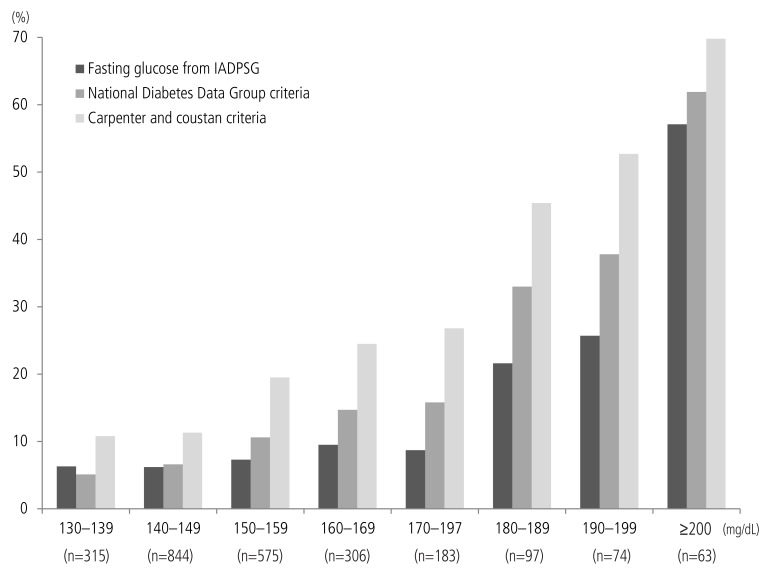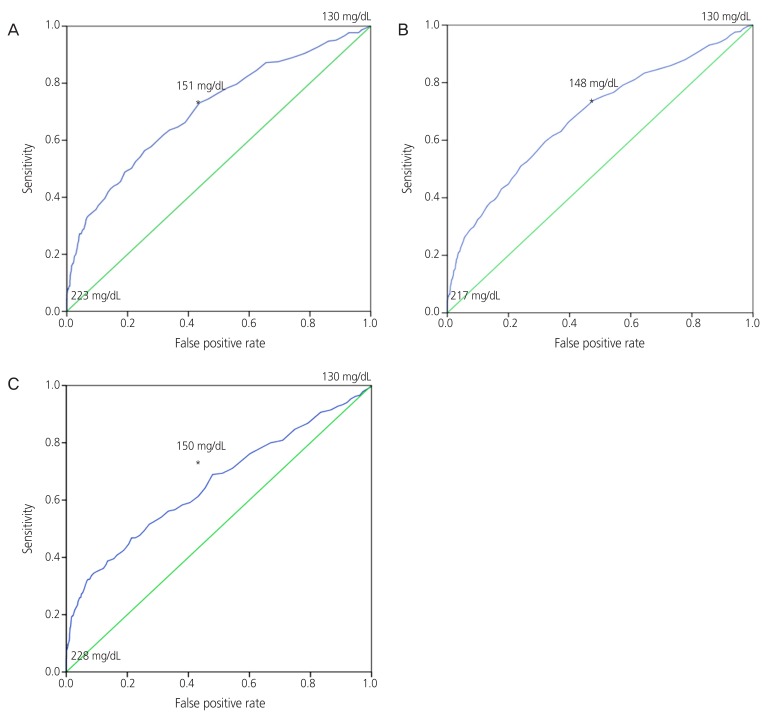1. Committee on Practice Bulletins: Obstetrics. Practice Bulletin No. 137: gestational diabetes mellitus. Obstet Gynecol. 2013; 122(2 Pt 1):406–416. PMID:
23969827.
2. Plagemann A. A matter of insulin: developmental programming of body weight regulation. J Matern Fetal Neonatal Med. 2008; 21:143–148. PMID:
18297568.

3. Tam WH, Ma RC, Yang X, Li AM, Ko GT, Kong AP, et al. Glucose intolerance and cardiometabolic risk in adolescents exposed to maternal gestational diabetes: a 15-year follow-up study. Diabetes Care. 2010; 33:1382–1384. PMID:
20215448.
4. Vandorsten JP, Dodson WC, Espeland MA, Grobman WA, Guise JM, Mercer BM, et al. NIH consensus development conference: diagnosing gestational diabetes mellitus. NIH Consens State Sci Statements. 2013; 29:1–31. PMID:
23748438.
5. Carpenter MW, Coustan DR. Criteria for screening tests for gestational diabetes. Am J Obstet Gynecol. 1982; 144:768–773. PMID:
7148898.

6. Berggren EK, Boggess KA, Stuebe AM, Jonsson Funk M. National Diabetes Data Group vs Carpenter-Coustan criteria to diagnose gestational diabetes. Am J Obstet Gynecol. 2011; 205:253.e1–253.e7. PMID:
22071053.

7. Hartling L, Dryden DM, Guthrie A, Muise M, Vandermeer B, Aktary WM, et al. Screening and diagnosing gestational diabetes mellitus. Evid Rep Technol Assess (Full Rep). 2012; 210:1–327. PMID:
24423035.
8. HAPO Study Cooperative Research Group. Metzger BE, Lowe LP, Dyer AR, Trimble ER, Chaovarindr U, et al. Hyperglycemia and adverse pregnancy outcomes. N Engl J Med. 2008; 358:1991–2002. PMID:
18463375.

9. Benhalima K, Devlieger R, Van Assche A. Screening and management of gestational diabetes. Best Pract Res Clin Obstet Gynaecol. 2015; 29:339–349. PMID:
25457858.

10. Bonomo M, Gandini ML, Mastropasqua A, Begher C, Valentini U, Faden D, et al. Which cutoff level should be used in screening for glucose intolerance in pregnancy? Definition of Screening Methods for Gestational Diabetes Study Group of the Lombardy Section of the Italian Society of Diabetology. Am J Obstet Gynecol. 1998; 179:179–185. PMID:
9704785.
11. Caliskan E, Kayikcioglu F, Ozturk N, Koc S, Haberal A. A population-based risk factor scoring will decrease unnecessary testing for the diagnosis of gestational diabetes mellitus. Acta Obstet Gynecol Scand. 2004; 83:524–530. PMID:
15144332.

12. Cetin M, Cetin A. Time-dependent gestational diabetes screening values. Int J Gynaecol Obstet. 1997; 56:257–261. PMID:
9127158.
13. Weerakiet S, Lertnarkorn K, Panburana P, Pitakitronakorn S, Vesathada K, Wansumrith S. Can adiponectin predict gestational diabetes? Gynecol Endocrinol. 2006; 22:362–368. PMID:
16864145.

14. van Leeuwen M, Zweers EJ, Opmeer BC, van Ballegooie E, ter Brugge HG, de Valk HW, et al. Comparison of accuracy measures of two screening tests for gestational diabetes mellitus. Diabetes Care. 2007; 30:2779–2784. PMID:
17698616.

15. Thitadilok W, Techatraisak K. The screening for gestational diabetes employing 50 g glucose test. J Med Assoc Thai. 1995; 78:526–531. PMID:
8576659.
16. Rey E, Hudon L, Michon N, Boucher P, Ethier J, Saint-Louis P. Fasting plasma glucose versus glucose challenge test: screening for gestational diabetes and cost effectiveness. Clin Biochem. 2004; 37:780–784. PMID:
15329316.

17. van Leeuwen M, Louwerse MD, Opmeer BC, Limpens J, Serlie MJ, Reitsma JB, et al. Glucose challenge test for detecting gestational diabetes mellitus: a systematic review. BJOG. 2012; 119:393–401. PMID:
22260369.

18. Sacks DA, Abu-Fadil S, Karten GJ, Forsythe AB, Hackett JR. Screening for gestational diabetes with the one-hour 50-g glucose test. Obstet Gynecol. 1987; 70:89–93. PMID:
3601272.
19. Yogev Y, Langer O, Xenakis EM, Rosenn B. Glucose screening in Mexican-American women. Obstet Gynecol. 2004; 103:1241–1245. PMID:
15172859.

20. Atilano LC, Lee-Parritz A, Lieberman E, Cohen AP, Barbieri RL. Alternative methods of diagnosing gestational diabetes mellitus. Am J Obstet Gynecol. 1999; 181(5 Pt 1):1158–1161. PMID:
10561637.

21. Cheng YW, Esakoff TF, Block-Kurbisch I, Ustinov A, Shafer S, Caughey AB. Screening or diagnostic: markedly elevated glucose loading test and perinatal outcomes. J Matern Fetal Neonatal Med. 2006; 19:729–734. PMID:
17127496.

22. Kim JH, Seo YS, Choi SJ, Kim YA, Roh CR, Yang SH. The relationship of the results of 50-g screening test and gestational diabetes. Korean J Obstet Gynecol. 2003; 46:2146–2150.
23. Bobrowski RA, Bottoms SF, Micallef JA, Dombrowski MP. Is the 50-gram glucose screening test ever diagnostic? J Matern Fetal Med. 1996; 5:317–320. PMID:
8972407.

24. Landy HJ, Gomez-Marin O, O'Sullivan MJ. Diagnosing gestational diabetes mellitus: use of a glucose screen without administering the glucose tolerance test. Obstet Gynecol. 1996; 87:395–400. PMID:
8598962.

25. Sibai BM, Viteri OA. Diabetic ketoacidosis in pregnancy. Obstet Gynecol. 2014; 123:167–178. PMID:
24463678.

26. Madaan M, Aggarwal K, Sharma R, Trivedi SS. Diabetic ketoacidosis occurring with lower blood glucose levels in pregnancy: a report of two cases. J Reprod Med. 2012; 57:452–455. PMID:
23091997.
27. Mayo K, Melamed N, Vandenberghe H, Berger H. The impact of adoption of the international association of diabetes in pregnancy study group criteria for the screening and diagnosis of gestational diabetes. Am J Obstet Gynecol. 2015; 212:224.e1–224.e9. PMID:
25173183.






 PDF
PDF ePub
ePub Citation
Citation Print
Print




 XML Download
XML Download